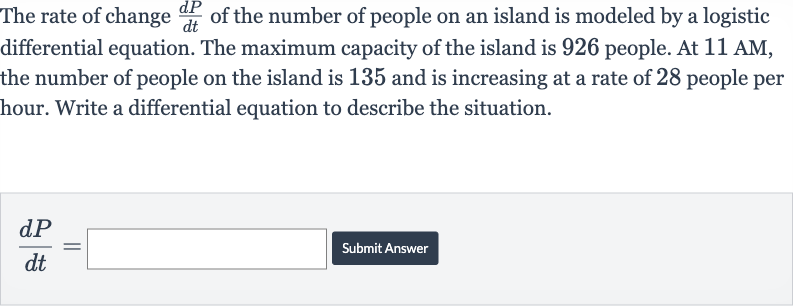AI tutor
Welcome to Bytelearn!
Let’s check out your problem:

The rate of change of the number of people on an island is modeled by a logistic differential equation. The maximum capacity of the island is people. At , the number of people on the island is and is increasing at a rate of people per hour. Write a differential equation to describe the situation.
Full solution
Q. The rate of change of the number of people on an island is modeled by a logistic differential equation. The maximum capacity of the island is people. At , the number of people on the island is and is increasing at a rate of people per hour. Write a differential equation to describe the situation.
- Logistic Differential Equation: The logistic differential equation is generally given by the formula:where is the population at time , is the intrinsic growth rate, and is the carrying capacity of the environment. In this case, is given as people.
- Given Population and Rate: We are given that at AM, the number of people on the island is , which is at , and the rate of increase is people per hour. However, we need to find the intrinsic growth rate to complete the differential equation.
- Calculate Intrinsic Growth Rate: To find the intrinsic growth rate , we can use the given rate of increase when . Plugging these values into the logistic equation, we get:Now we need to solve for .
- Calculate Fraction of Carrying Capacity: First, calculate the fraction of the carrying capacity:
- Calculate Term: Now, multiply this fraction by to find the term :
- Calculate Intrinsic Growth Rate: Next, divide the rate of increase by this term to find :
- Complete Differential Equation: Now that we have , we can write the complete logistic differential equation:This is the differential equation that describes the situation.
More problems from Interpreting Linear Expressions
QuestionGet tutor help
